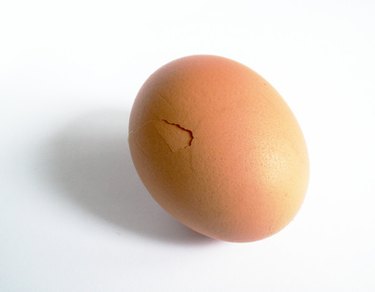Things You'll Need
Box of Plaster of Paris
9 inch round clear latex balloon
1/2 liter water bottle
Funnel
Large mixing bowl
Soft pillow
Water
Razor blade
320-grit sandpaper
Towels
Drop cloth

There are numerous crafty projects that call for dinosaur eggs, and chances are, you don't have a pet dinosaur to lay them for you. So, if you need large dinosaur eggs for a specific project, you need to make your own. While you can use papier-mache, it often produces poor-quality eggs and doesn't work if you need eggs that can be realistically broken. Using Plaster of Paris, you can create large dinosaur eggs that are hollow and can be broken like real egg shells!
Step 1
Mix the plaster thoroughly in the mixing bowl. At first, use the instructions on the box to produce a batch of plaster. However, this plaster will probably be too thick for this project, so you may need to add extra water. Add 1 tablespoon of extra water at a time until the mix is smooth and runny, with the consistency of a thin milkshake.
Video of the Day
Step 2
Use the funnel to fill the water bottle to the top with plaster.
Step 3
Wrap the balloon's lip over the bottle's mouth. Turn the bottle upside-down, then support the balloon with one hand as you squeeze the bottle with the other. This injects plaster into the balloon. Continue squeezing the bottle until you have emptied as much of the plaster into the balloon as possible.
Step 4
Remove the balloon from the bottle and clean the lip. Then inflate the balloon to the desired egg's size and tie the lip sealed.
Step 5
Coat the inside of the balloon with plaster by quickly rotating the balloon. Once the inside is totally coated, slowly rotate the balloon to move the plaster over thin areas. Areas that need more plaster appear streaked or darker than the surrounding plaster. You may also feel a difference between the thicker and thinner areas of the balloon.
Step 6
Once the balloon begins to feel firm, stop rotating and set it on the pillow. Rotate the balloon a quarter turn every 60 seconds for the next eight to 10 minutes. Do not forget to rotate the balloon in all directions, including the top and bottom.
Step 7
Leave the balloon undisturbed for five hours. This allows the plaster to harden.
Step 8
Cut the balloon with the razor blade and allow it to rip and peel away from the underlying plaster. Use only light pressure so you do not damage the plaster.
Step 9
Leave the plaster egg to sit for at least one day. This allows water moisture to evaporate, so the egg completely hardens.
Step 10
Sand the end of the plaster egg where the balloon's lip made a mark.
Tip
Do this project on the drop cloth, as plaster inevitably gets spread around.
You must perform steps one through six very quickly! The plaster sets fast so seconds count.
Warning
The Plaster of Paris may cause eye, skin, or respiratory irritation. Use in a well ventilated area and use eye protection.
When inflating the plaster-filled balloon, it is possible that the balloon could pop, resulting in a very messy explosion.
Video of the Day